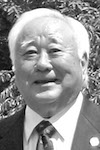
Gerald Yamada
President Franklin D. Roosevelt signed Executive Order 9066 on Feb. 19, 1942, authorizing the military to evacuate persons of Japanese ancestry from the West Coast.
The implementation of EO 9066 unjustly disrupted the lives of 120,000 persons. Subsequent government actions have attempted to correct the harm done by EO 9066. These actions include:
- The Supreme Court in the Endo case unanimously rules that loyal citizens of the United States could not be detained without cause. Although the Supreme Court issued this decision in 1944, the Roosevelt administration delayed the release of Japanese Americans for nine more months before closing the first War Relocation Authority camp.
- President Gerald Ford rescinds EO 9066 on Feb. 19, 1976.
- The 1982 report of the Commission on Wartime Relocation and Internment of Civilians concludes that EO 9066 and the actions taken under its authority were motivated by “prejudice, war hysteria and lack of political leadership.”
- The Civil Liberties Act of 1988 apologizes for the evacuation, relocation and internment of persons of Japanese ancestry during World War II and authorizes a redress payment to those interned who were still living on the date of enactment.
- Public Law 102-502 (1992) authorizes a national memorial in Washington, D.C., to honor Japanese American patriotism in World War II. The National Japanese American Memorial was built and dedicated in 2000.
- Public Law 109-441 (2006) creates a federal grant program to preserve the confinement sites used during World War II to imprison persons of Japanese ancestry. This program is presently administered by the National Park Service.
- Congress awards the Congressional Gold Medal to the Nisei soldiers who served in the 442nd Regimental Combat Team, 100th Infantry Battalion and Military Intelligence Service. The official ceremony was held in 2011 in the U.S. Capitol.
- In 2011, the Department of Justice makes a public admission that President Roosevelt’s Solicitor General withheld evidence from the Supreme Court in the Korematsu case that supported Fred Korematsu’s argument that there was no “military necessity” to justify EO 9066.
- The Supreme Court in the 2018 Trump v. Hawaii case reverses the Korematsu decision and calls EO 9066 a “morally repugnant order.”
These actions, however, do not fully rectify the harm that was inflicted by EO 9066. The Japanese American community still has unfinished business. We must ensure that those responsible for EO 9066 and its implementation are held accountable for their actions.
This isn’t being done. For example, the Japanese American Citizens League’s February 2019 Day of Remembrance stated in part, “We remember the racism and xenophobia against Japanese and other Asian communities that led up to the issuance of Executive Order 9066.”
The remainder of the message speaks to the negative impacts that EO 9066 had on persons of Japanese ancestry during World War II. The message fails to identify the perpetrators of the racism and their motives that led to the issuance of EO 9066.
This is a glaring omission in JACL’s DOR message. JACL’s leadership needs to have the courage, just as the JACL leaders did during World War II, to call it like it is.
In identifying those responsible, we must start with President Franklin D. Roosevelt, who used “war hysteria” to promote prejudice and political ambitions. His role and motives for issuing EO 9066 do not appear to be publicly acknowledged by the government.
For example, on my visit to the FDR National Memorial, located on the National Mall in Washington, D.C., I could find no mention that President Roosevelt signed and issued EO 9066.
Yet, our taxpayer dollars are used to maintain a national memorial in honor of a president who never apologized for his actions that illegally disrupted the lives of 120,000 persons of Japanese ancestry, most of whom were American citizens.
By ignoring President Roosevelt’s role and motives for issuing EO 9066, this national memorial hides from the American people the truth about the racism that was used to imprison persons of Japanese ancestry in America’s concentration camps.
We need to use future DOR events and messages as opportunities to identify the persons who used EO 9066 to promote their racist agenda and political ambitions and engage in a broader discussion on why EO 9066 was issued.
We must ensure that history holds the persons responsible for Executive Order 9066 accountable for their actions. We owe this to those who suffered under EO 9066, to ourselves and to future generations.
Gerald Yamada is a past president and pro bono general counsel of the Japanese American Veterans Assn.; past part-time executive director and pro bono general counsel to the National Japanese American Memorial Foundation; governor of the Japanese American National Museum; national coordinator and chief strategist for the National Japanese Heritage Coalition that created the legislative initiative authorizing the Japanese American Confinement Sites Program; founder and current treasurer for the National Japanese American Political Action Committee; and a past Washington, D.C., JACL chapter president. The views expressed in this article are those of the author and are not necessarily those of the organizations with whom he is or has been associated with.



